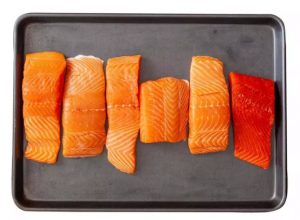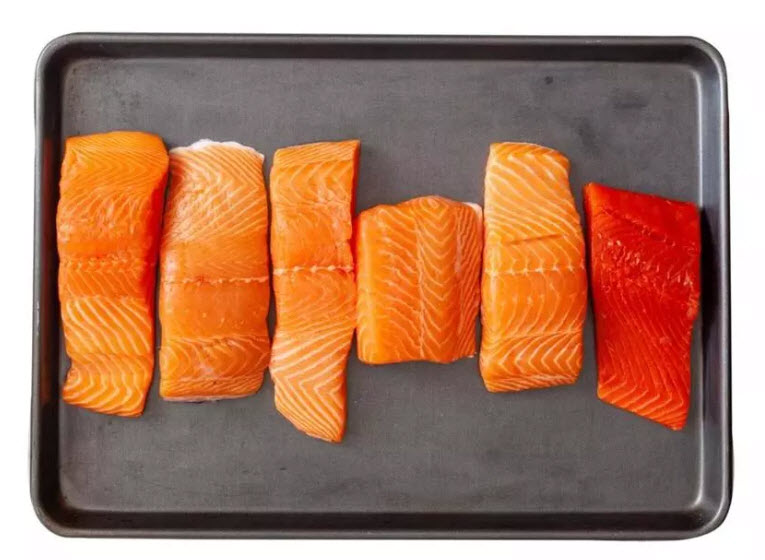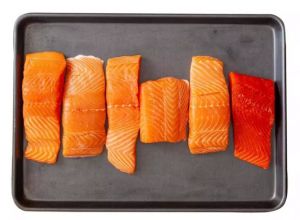Anytime: Salmon Business reports that the Chief Executive of Mowi, Alf-Helge Aarskog told students at the Norwegian University of Life Sciences that his company’s recent change of name was part of a change of mindset about using marketing as an important part of the future development of the company. He continued that after rebranding, Mowi has invested in marketing but that it has become clear that one thing that is in short supply in the salmon farming industry is knowledge of when is the right time to eat salmon. Is it Christmas? Easter or is it lunch? Mr Aarskog also asked how often can salmon be eaten? This is something that Mowi have not considered. He said that if you ask others in the industry, they don’t seem to know either.
We, at Callander McDowell, have been studying the consumer market for over twenty years and we would suggest that there is a simple answer to Mr Aarskog’s question. This is that consumers can eat salmon whenever they want and as often as they want. There is no magic formula and nor we would expect there to be.
The question Mr Aarskog should be asking is how as a company such as Mowi can present salmon in sufficient forms that consumers are given a choice to eat salmon whenever they want, whether it be salmon and eggs for breakfast, a sandwich for lunch or a gourmet meal for dinner. It is about diversifying the offering to provide this choice.
The problem with the salmon industry today is that the industry analysts have forced the industry to focus on price rather than the market and as such elevated prices have made diversification generally too expensive to pursue.
Some of our readers may remember that back in the 1980s salmon was considered special. The peak times for consumption were Christmas and Easter but as salmon has become more widely available, these peaks have diminished. However, to make salmon more attractive to a wider range of consumers, the industry must become even more market-led. It is not enough to just offer a piece of salmon flesh, consumers need to be enticed to eat more salmon by a greater variety of product choice.
Boston tastes: In the run up to the Boston Seafood Show, the Boston Globe has investigated the choices when buying salmon. They say this can be confusing. What is clear from the article is that there is a lot of confusion. This begins immediately when they write that salmon comes in many varieties including salmon from British Columbia, Canada, Norway, Faroe Islands, Scotland and Alaska Sockeye.
Sheryl Julian continues that she sees several kinds of salmon on the fish counter. A farmed salmon form Norway, a wild Alaskan salmon that’s marked as previously frozen and is 10 shades redder than the Norwegian and twice the price. She says that she has seen salmon from the Faroes on restaurant menus but rarely seen in stores. She has also heard of farmed salmon from Eastern Canada.
Sheryl spoke to Kim Marden of Captain Marden’s who supplied some of the salmon for a taste test. Kim said that one of the things that produces good tasting fish is the base of the feed. In every region of the world where salmon is farmed, the salmon are fed the local fish in the waters in which they are raised. Farmed salmon in Maine or Eastern Canada, for instance, are getting herring. In Norway and Scotland, it’s krill. Even so salmon from Norway and Scotland can taste quite different depending on what else is added to the formula and how much the fish are getting, the conditions in the water and other aquaculture practices.
We, at Callander McDowell, have tasted a lot of salmon and we are not sure we agree with Kim Marden. In our experience, most people don’t eat enough salmon to be able to determine significant differences between salmon of different origin. We believe that any significant differences between different salmon are more likely to be due to how the fish has been handled at the consumer-facing end of the supply chain rather than how it was produced. It can also depend on the cut of salmon supplied.

Boston Globe’s salmon – from Left BC, Canada, Norway, Faroes, Scotland and Sockeye.
The taste test revealed a preference for Scottish salmon from Wester Ross $14.95/lb and Faroe Isles salmon from Hidden Fjord $14.99/lb. Norwegian salmon $9.99/kg from Kvaroy was found to be moist but with little taste. Salmon from Iceland $8.99/lb had a soft texture and an unremarkable taste. The Eastern Canadian salmon $12.99/lb was deemed to be chewy, dry and rather bland. It didn’t flake easily.
Whilst Sheryl began her article by saying that buying salmon was confusing, she didn’t manage to clarify that part of this confusion is because not all salmon are the same species. The fish so far tasted are all Atlantic salmon whereas the others are different species of Pacific salmon. There are five species of Pacific salmon are they are all very different to Atlantic salmon in their taste and their eating. Sheryl alludes to the dense texture of Sockeye salmon but failed to explain that these are completely different fish.
The taste test tasted two different pieces of wild Alaskan Sockeye; one at $14.99/lb and the other at $9.99/kg. The fish is described as dark red with lean firm flesh that seems meaty. It has more flavour than farmed(?) but the dense texture is not ‘winning’. The cheaper frozen sockeye was described as not as red and was dry with little flavour. This illustrates our point about how the fish is handled after it enters the supply chain.
The final fillet tested was farmed organic King (Chinook) salmon from British Columbia $25.00/lb. It has a firm texture with a mild salmon-y taste. The testers didn’t think it was worth the premium price.
Whilst, there were favourites amongst the fish tasted, we suspect that if the testers had been given just one fillet to taste they would have been more than happy with it. It is only when salmon fillets are tasted together that any differences are apparent.
Smile: It seems that despite the fact that vegans are unlikely to eat fish due to the fact that fish are animals that have to be killed, Seafish is persisting with its Think Seagan campaign. One of the latest messages is that people are eating too much sugar so instead of choosing a sweet snack such as muffins, pastries or cakes, they should choose a fish-based snack instead. They suggest a crab salad, tuna sandwich, a box of sashimi or a pot of cooked prawns.
Seafish say that it is no surprise that fish is sugar free, but less well known that fish contains nutrients important for maintaining healthy teeth including phosphorus and vitamin D.
This very much sounds as if Seafish are clutching at straws. We can’t imagine visiting the local coffee shop for a mid-morning coffee and asking for a pot of prawns rather than a Danish pastry and we would be surprised if Seafish could highlight even one person who chooses to eat fish as a way of protecting their teeth. Most people use toothpaste.
We were interested to see that the Scotsman’s food and drink section featured Seafish’s ‘Think Seagan campaign but chose to also highlight the drawbacks of this approach to food.
They highlight that the Vegan Society have warned that it is good that people are moving away from eating meat and dairy, but that eating fish can have a big impact on the levels of mercury in the blood. They also say that fishing has caused 90% of fish stocks to be exterminated in the last fifty years
The newspaper also spoke to the British Dietetic Association who said that there is no need to include seafood in the diet as we can all thrive by eating healthy and delicious plant food.
It seems that Seafish has got a long way to go to persuade the public about the benefits of a Seagan diet.
Dee Dums: According to the Press and Journal, River Dee management has expressed ‘deep concern’ over a ‘dramatic decline’ in young salmon making their migration to the sea. The River Dee Trust has published its findings of its 2018 smolt tagging and tracking research, which they say has shown further ‘huge losses’ of young fish trying to make their way to sea. Of 100 smolts tagged by the Trust, 48% did not complete their migration and a total of 28% were lost in the harbour where dredging work has been carried out.
Rather surprisingly, there has been a muted response to this news from the wild fish sector. Instead, the focus continues to be on the impacts of salmon farming. The Field magazine published an editorial from Paul Knight of Salmon & Trout Conservation bemoaning the lack of action against the salmon farming after two Scottish Parliamentary hearings. Sir Michael Wigan, titled his column in Scottish Field ‘Blame Aquaculture’ whilst Salmon & Trout magazine published three letters attacking Hamish Macdonell of the SSPO for suggesting that there was a lack of evidence that salmon farming was responsible for the declines of wild fish.
Andrew Graham Stewart of Salmon & Trout Conservation issued a press release that condemned the salmon industry for not publishing weekly data on sea lice numbers on a farm by farm basis as close to real time as possible. This is despite his inability to link lice numbers directly to declines of wild salmon. We have mentioned previously that by equating numbers of fish to a report commissioned by Salmon & Trout Conservation, the decline of wild fish due to salmon farming as a percentage of total Scottish catch is approximately one-percent. By comparison, 95% of migrating wild salmon fail to return to their home rivers. The wild fish sector has blamed the salmon farming industry for so long that they have continually failed to address the real issues affecting wild fish. As Sir Michael Wigan argues ‘Blame Aquaculture’.
Whether it is just a coincidence or not, Salmon Business has reported that Marine Scotland is now to release monthly data on sea lice numbers. Ruth Allen of Marine Scotland told Salmon Business that ‘publishing the data was simply done in the interests of transparency as per the core objective of our farmed fish health framework.’
However, it seems that this move to transparency is a one-way street. It seems to apply to salmon farming only. Whilst the wild fish sector is demanding transparency from the salmon farming industry, they appear loathe to adopt the same transparency to their own activities. For example, whilst they demand weekly publication of sea lice data, we, at Callander McDowell are still waiting for publication of the salmon and sea trout catch data for January 2018 – some fifteen months ago. How can we determine whether stocks of salmon and sea trout are in decline when that data is so out of date? Why cannot angling catches be published on a weekly basis too? Surely, it cannot be too difficult to record the number of fish caught and then either killed or released and post the numbers on a national website.
At the beginning of March, the Tweedbeats website said that without giving too much away about the final catch of salmon and sea trout from the River Tweed, Mr William Younger, who keeps a running record of catches, estimated the catch at 5,580 last November, a figure which is 99% accurate. According to Tweedbeats, Mr Younger compiles his figures from two different websites and several non-reporting beats, and he should be thanked by everyone who likes to be dealing with accurate up to date figures for the Tweed as a whole rather than the partial and therefore inaccurate and misleading data recorded elsewhere. It seems that it is not just us that are unhappy with the way that wild fish data is recorded.
In fact, when that Scottish Government data is finally published, it is the total figure for each fishery district. There is no information about the catches for each individual beat. In our opinion, we suspect that this deficiency is simply related to a reluctance to admit how many fish are actually caught in each beat and how this relates to the price charged for the fishing.
Whatever reason, it is simply unacceptable to have to listen to accounts of how wild fish are in such decline yet have no access to any data to be able to judge such claims.


